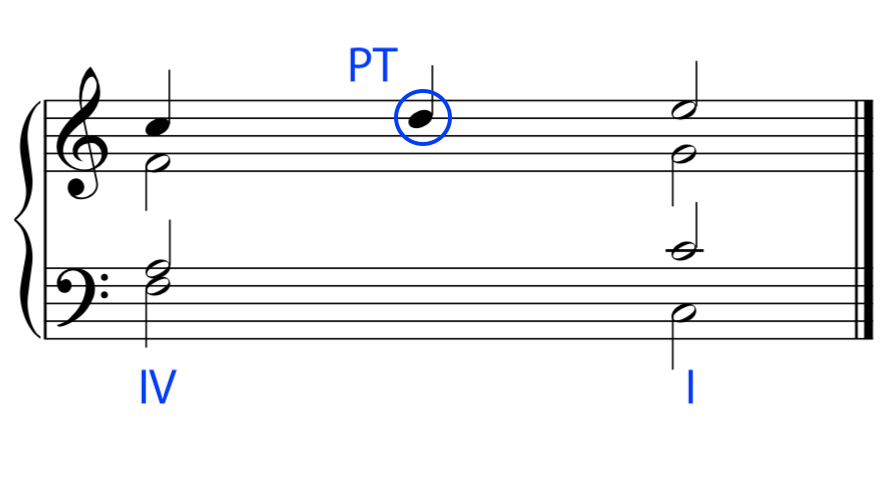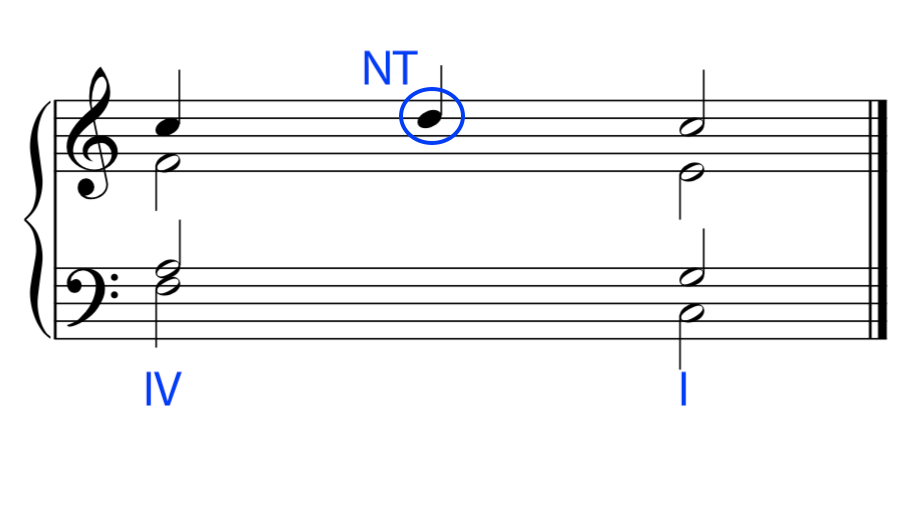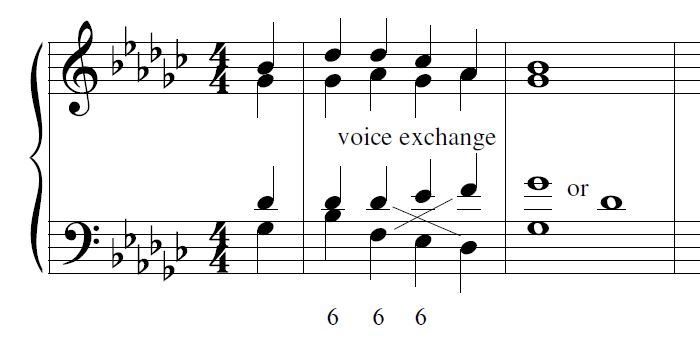6.2 Embellishing Tones: Writing Passing Tones and Neighbor Tones
7 min read•june 18, 2024
Sumi Vora
AP Music Theory 🎶
72 resourcesSee Units
In the previous unit, we learned what non-chord tones and embellishments were, and we went in-depth about passing tones and neighbor tones. In this section, we will learn how to write passing and neighbor tones according to 18th-century voice leading conventions. First, however, let’s review what passing and neighbor tones are.
Review of Passing Tones and Neighbor Tones
Passing Tones
A passing tone in music is a non-chord tone that is played or sung briefly as a transition between two chord tones in a melody or harmony. It is typically used to create a sense of movement or tension and release in a piece of music. They are used to connect or "pass" between the strong and stable tones of a chord, adding a sense of motion and flow to the music. If there are skips or leaps between successive chords in a harmonic progression, adding a passing tone or multiple passing tones can also help to improve voice leading and ensure that voices are mostly moving in a stepwise manner.
Let’s consider an example, where we move from a I chord to a iii chord in a melody. In the bass line, we will have a tonic followed by a mediant. In between the tonic and mediant, we might add a supertonic passing tone so that the bass line moves stepwise from the tonic to the supertonic to the mediant. For example, if we are in Ab Major, we might have an Ab-Bb-C melody in the bass line.
Most of the time, though, we add melodic embellishments and non-chord tones to the upper voices – specifically the soprano line. This is because when you are playing music, your ears usually interpret the higher notes as the “melody line,” and the lower notes as the harmonic accompaniment. So, when adding passing tones, focus on incorporating them into the soprano line.
It is okay to add multiple passing tones between two voices. For example, if the soprano voice must leap from a C to an F, you can add a D and an E between the two chord tones. Be careful to make sure that you are counting correctly when you do this! For example, if the harmonic rhythm is in half notes, it would be wrong to add three quarter notes in passing tones in the soprano line. Instead, you may consider having the chord tone be a quarter note, and the two passing tones following it to be eighth notes. Unless you are writing a suspension, which we will cover in later units, it should always be the case that the chord tone falls on the “harmonic beat,” so to speak.
Usually, passing tones, as well as almost all other embellishments, should be written on the weaker beats. However, we can classify passing tones as accented or unaccented. An unaccented passing tone is written on a weaker beat in comparison to the chord tones surrounding it. An accented passing tone is written on a stronger beat than the chord tones surrounding it. As you can see, writing an accented passing tone requires disrupting the harmonic rhythm of the piece, which can be done in order to create tension and rhythmic interest, but was usually done sparingly by composers in the Common Practice Era.
Next, let’s look at an example of passing tones:

Image via https://kaitlinbove.com/nonharmonic-tones
Passing tones can also be chromatic, meaning that they don’t fall within the diatonic scale of the key that the piece of music is written in. This often happens when voices are moving stepwise, but the composer still wants to add a passing tone in order to create melodic interest. For example, if a voice is moving from C to D, the composer might add a chromatic passing tone such that the voice goes from C to C# to D. If the composer is connecting a skip or a leap, they might also use part of the chromatic scale in order to add passing tones between the two chord tones. For example, when leaping down from an A to an F, they might add the passing tones G#-G-F# in order to create the chromatic melodic line A-G#-G-F#-F. Chopin’s Waltz Op 69 No 2 gives a good example of these types of chromatic passing tones.
Neighbor Tones
A neighbor tone in music is a non-chord tone that is played or sung immediately before or after a chord tone within a melody or harmony. Neighbor tones are used when a chord tone is sustained from one chord to another, meaning that the note in the voice stays the same for both chords. In this case, adding a neighbor tone means adding a note above or below the sustained note. For example, if there is a C in the soprano voice that is sustained for two chords, you can step down such that you have a C-B-C melody in the soprano voice.
A neighbor tone is similar to a passing tone in that it is used to create a sense of movement or tension and release in a piece of music, but it typically stays within a smaller range and returns to the same chord tone it started from. Neighbor tones are often used to create a sense of ornamentation or decoration in a melody and can be used to create a sense of anticipation or delay in the resolution of a chord. There are two types of neighbor tones: upper neighbor and lower neighbor. An upper neighbor tone occurs when a note is approached by a note of a higher pitch and then returns to the original note. A lower neighbor tone is when a note is approached by a note of a lower pitch and then returns to the original note.
Here is an example of a neighbor tone:

Image via https://kaitlinbove.com/nonharmonic-tones
Just like passing tones, neighbor tones can either be diatonic (meaning that the neighbor tone is within the diatonic scale of the key that the piece is written in) or they can be chromatic (meaning that the neighbor tone is outside of the diatonic scale that the piece is written in). Either way, in order to be classified as a neighbor tone, the voice must move stepwise. In a C-E-C melody, the E would not be considered an upper neighbor tone. (It is actually an escape tone, which we will learn about in section 6.3).
Writing Passing and Neighbor Tones
In 18th-century style Western music, it is common to write passing and neighbor tones in one of the outer voices – typically the soprano line, but sometimes also the bass line. If you write passing or neighbor tones in the soprano line, you have significant freedom regarding where to place these tones and, sometimes, regarding whether they are accented or unaccented. By convention, though, both passing and neighbor tones in the soprano line are written as unaccented non chord tones.
One of the reasons why most of the melodic embellishments happen in the soprano line is that it is more acceptable for the bass line to have skips and leaps compared to the soprano line. Therefore, if other voice leading considerations necessitate a leap in the soprano line, it would be pragmatic to add a few passing tones in order to ensure that the soprano line moves stepwise.
Another reason why most melodic embellishments are written in the soprano line is because the soprano line is usually “heard” as the primary melodic line by listeners, since it is in the highest register. Hence, composers try to embellish the soprano line because it is more impactful in terms of adding expression and melodic interest to a piece of music.
When writing non chord tones in the bass line, you should usually accompany them with a stationary soprano line, meaning that both the soprano lines and bass lines should not be moving at the same time. If all of the chords occur on a quarter note, for example, then it would be appropriate to insert a passing tone or a neighbor tone on the eighth note, such that the non chord tone occurs on a weak beat, and the chord tones both occur on the beat or the harmonic rhythm. Similarly, if the chords progress by half note, you can add a quarter note as a passing or neighbor tone, or perhaps three eighth notes as passing tones between the lines.
Another consideration when adding non chord tones to the bass line is voice exchange, in which the bass line swaps notes with the soprano line. For example, if the bass line moves up stepwise G-A-B, where A is a passing tone, and the soprano voice moves down by leap from B to G, this would be voice exchange between the soprano and bass lines. If you can achieve this in your music, adding non-chord tones in the bass line between the exchanged voices sounds really beautiful.
Here is an example of voice exchange:

Image via
Music Stack Exchange
Finally, if the bass line moves in parallel thirds or sixths with the soprano line, then it might be a good idea to add some non-chord tones in the bass line to add tension to the parallel consonant intervals.
Browse Study Guides By Unit
🎵Unit 1 – Music Fundamentals I (Pitch, Major Scales and Key Signatures, Rhythm, Meter, and Expressive Elements)
🎶Unit 2 – Music Fundamentals II (Minor Scales and Key Signatures, Melody, Timbre, and Texture)
🎻Unit 3 – Music Fundamentals III (Triads and Seventh Chords)
🎹Unit 4 – Harmony and Voice Leading I (Chord Function, Cadence, and Phrase)
🎸Unit 5: Harmony and Voice Leading II: Chord Progressions and Predominant Function
🎺Unit 6 – Harmony and Voice Leading III (Embellishments, Motives, and Melodic Devices)
🎤Unit 7 – Harmony and Voice Leading IV (Secondary Function)
🎷Unit 8 – Modes & Form
🧐Exam Skills
📚Study Tools

Fiveable
Resources
© 2025 Fiveable Inc. All rights reserved.